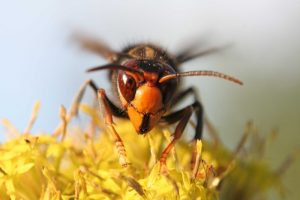
The Asian hornet, also known as the yellow legged hornet, is native to Asia and was confirmed for the first time in Lot-et-Garonne in the South West of France in 2004. It was thought to have been imported in a consignment of pottery from China and it quickly established and spread to many regions of France. The hornet preys on honeybees, Apis mellifera and disrupts the ecological role which it provides, harming commercial beekeeping activities. It has also altered the biodiversity in regions where it is present and is potentially deadly to allergic people. All beekeepers should remain vigillant and be on the look out for it in their apiaries.
Appearance and biology of the Asian hornet
Vespa velutina (Asian hornet (AH)) and Vespa crabro (European hornet) can be easily distinguished from each other. The AH is smaller than our native European hornet and has a black and yellow appearance which contrasts the brown and brownish yellow of V. crabro. Nests are founded by a single queen who rapidly starts laying eggs after building her nest in April. As the colony size increases through the summer, it will reach an average population of 6000 individuals and in July, hornets will begin predating on honey bee colonies; hornet brood requires animal proteins which are transformed into flesh pellets and then offered to the larvae. This hunting behaviour can continue well into the end of November. In autumn (around September), the nest will focus on the production of potential queens (on average 350) and male drones, who will mate with the queens. These mated queens will overwinter and leave the workers and males to die before winter. The following spring, the fertilised founder queens will begin the production of a new colony.

V. velutina should not confused with the Giant Asian hornet, sometimes referred to as the ‘Japanese hornet’ .
Monitoring for the Asian hornet
Firstly, make sure you know how to recognise Asian hornets – a very helpful ID sheet is available. Monitoring for arrival of the AH is strongly encouraged throughout the UK, but especially in areas where likelihood of arrival is considered to be highest (S & SE England). Beekeepers who are participating in the Sentinel Apiary programme can download guidance notes about monitoring for the Asian hornet and other members of the public should also consider hanging hornet traps.Information from beekeepers in France shows that nest numbers are reduced by > 90% in areas where traps are deployed in springtime. Should the Asian hornets become established in the UK, springtime trapping will thus be a very useful management tool. When hanging out traps, please remember that it is important that damage to native wasps, hornets and any other insects is kept to an absolute minimum.
Where to report sightings and send in samples

If you think you have seen an Asian hornet, please notify the Great British Non Native Species Secretariat alert email address at alertnonnative@ceh.ac.uk immediately. Additionally, you can report sightings on their website. As well as this function, the website provides a great deal of information about the wide ranging work that is being done to tackle invasive species and tools to facilitate those working in this area.
It is also important that beekeepers sign up to BeeBase. In the event that the Asian hornet (or any other exotic threat to honey bee colonies) arrives here, efforts to contain it will be seriously jeopardised if we don’t know where vulnerable apiaries are located.
Finally, if you suspect that you have found an Asian hornet, you can send a suspect sample to the NBU laboratory for examination. Use a suitable sturdy container (cardboard rather than plastic) and provide as much detail as possible about the hornet and where you found it. See How to Send Samples into the Laboratory page. Digital photographs are also very useful to help with identification.
Useful media links
- The Animal and Plant Health Agency has set up a YouTube channel where the National Bee Unit has shared videos of our experience encountering the Asian Hornet in Andernos-les-Bains, South West France.
- BeeCraft magazine published a detailed article covering the lifespan, habitat and spread of the Asian hornet through France. Please see the article Vespa velutina–The Asian Hornet which also covers the impact on agriculture and honey bees. Follow-up articles have been produced in September and October 2011. These can be viewed here;
- Biologist Magazine published an article in May 2009 A foreigner in France: the Asian hornet written by Marie-Pierre Chauzat of the French Food Safety Agency and Stephen Martin from the University of Sheffield. We thank the authors for allowing us to attach this piece;
- Aliens- The Invasive Species Bulletin (Issue No 31, 2011) titled: Monitoring and control modalities of a honeybee predator, the yellow-legged hornet Vespa veluntina nigrithorax (Hymenoptera: Vespidae);
- A French articleLa découverte du Frelon asiatique Vespa velutina, en France (The discovery of the Asian hornet Vespa velutina in France) written by Claire Villemant and R Jean Haxaire from the French National Museum of Natural History and R Jean-Claude Streito from the French National Laboratory of Plant Protection – Entomology Unit.
Further reading
- Details about Vespa crabro, the hornet commonly found in the UK, can be viewed here. (For useful advice on the conservation of bees, wasps and ants within Great Britain and Ireland, visit Hymettus Ltd. The national society dedicated to studying and recording bees, wasps & ants (aculeate Hymenoptera) in Britain & Ireland is BWARS);
- Further details on Asian hornets can be viewed onI nventaire National du Patrimoine Naturel the website for National Inventory of Natural Heritage in France;
- To help distinguish between the many species of Vespa species, the French Museum of Natural History have produced an Identification Information Sheet.
Adapted from BeeBase, National Bee Unit, Animal Health and Plant Agency (APHA) under the terms of the Open Government Licence (OGL). Crown Copyright.